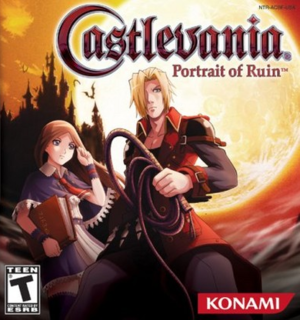The best Castlevania game since Symphony of the Night.
As evidence that this formula just continues to improve, yet another fine entry is produced in the form of Portrait of Ruin. Like previous "Castleroid" games, starting with the still-stellar (and still the best) Symphony of the Night, players take on the role of a hero out to beat Dracula and his minions, traversing a huge castle, finding countless weapons, armor, accessories, spells and other items to aid in the quest. The twist in this case is that there are two playable characters, Jonathan Morris and Charlotte Aulin, accessible at any time. Jonathan's the physical powerhouse, Charlotte's the magician, and both characters have merit. Using one does not hamper the abilities of the other in any way, so it pays to use the character that matches the situation. For instance, for the most part, Jonathan is the logical choice because he uses better and more powerful weapons, hits harder and takes more hits, but Charlotte's magic attacks are varied and powerful, and certain foes (like Legion) actually do less damage to her because of her higher magic and intelligence rating.
The player is able to summon and relieve an AI partner on the fly for a quick attack or a prolonged presence during gameplay. The AI partner can be moved or repositioned with the stylus, sprung off of for a lift, used to assist with puzzles and the like. Plus, the two characters can team up for one of several available co-op attacks that fill the screen and do huge damage. Playing with the two, switching in and out or having both of them present at the same time fighting side by side is a treat.
If you've played Symphony of the Night (PS1), Circle of the Moon, Harmony of Dissonance, Aria of Sorrow (all GBA) or Dawn of Sorrow (DS), then you'll find little new with the actual gameplay. Controls are tight and responsive and the challenge starts off a bit unforgiving but gets easier as you go along thanks to leveling up and finding stronger weapons and armor. You start out at the entrance to the castle and you gradually fill in the map as you go, locating teleport rooms, save rooms and portals to other areas.
Aside from the two character formula, there are some other differences in Portrait of Ruin from past Castlevania games. All attacks except for basic weapon attacks are tethered to magic; hearts are not separate as they were in previous games. When you use sub-weapons or spells, magic decreases. Candles and the like give out hearts when your magic is less than full, and random amounts of money when it is full. This means that you can build up money by using magic sparingly, or have an easier time of battle (depending on your skills and equipment, of course) by using magic more often. Sub weapons never appear in candles; they're bought, found, or obtained from enemy drops. Thus they can be equipped and switched like other weapons.
Another difference between Portrait of Ruin and previous Castlevanias is the structure. Now, the castle is like a hub that connects to different dimensions (the titular Portraits), each with their own map, teleport rooms, save points, and boss. In the end, it feels the same--you'll still have to explore carefully to find the items needed to unlock new abilities, opening up more of the castle.
Presentation-wise, it's gorgeous. The sprites are animated well, the visuals are vibrant and clear, the music is strong and the voice work is engaging too. It's cool to hear one character call the other by name when the player switches control from one to the other. As for the story, it's Castlevania...it's nothing amazing. Some twists, some turns, some historical references and homage to past Castlevania games, but mostly run-of-the-mill. But Castlevania's long-running mythos is rarely problematic and people don't play Castlevania games for the story, but for the perfect gameplay that has withstood over 20 years.
The game has massive amounts of replay value too. There are two sets of hidden characters to play through the game as, both playing quite a bit differently from the main characters. As usual, there is little to no story in these bonus modes and items can't be collected, but the challenge of going through the castle with these different characters is engaging nonetheless (though they're seriously overusing one in particular).
I could be nitpicky. I recently replayed SotN, and playing Portrait of Ruin makes me miss the ability to change the window color in the menu. I haven't dabbled in the online features at all, but I read that the multiplayer mode is extremely limited. That's too bad...2 player simultaneous play Castlevania through the whole game...that would be something else...but I guess now isn't the time. Also, despite the fact that these Castlevania games are based in different time periods, one can't tell by looking. The same gothic environments and enemies exist whether the game is based in the 1400s or the 21st century, and I think a bit more work in that regard is needed for future titles. I want to see Castlevania take place among skyscrapers and other modern environments.
In the end though, it's hard to find fault with Castlevania: Portrait of Ruin. These games are never bad. They're rarely revolutionary, but they're always fun to play. It never gets tiresome exploring every nook and cranny of the castle and finding the best equipment, even if your character is strong enough to beat the last boss with the first knife you ever get in one minute. As far as I'm concerned, they can keep making these games until the end of time. I can't wait until the next one...looking forward to the story behind that new female protagonist...

